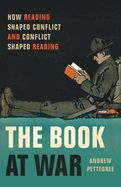
Books have a sort of magical property about them. They illuminate the darkened hallways of old thought with new ideas, bring adventure to the mundane, challenge readers with unfamiliar perspectives, and provide a script for hope during times of war. In The Book at War, Andrew Pettegree (The Invention of News) takes the book, this simple instrument of thought, through decades of war, examining how it was used for liberty and suppression alike. He explores how the U.S. was once the leading force in the notion of the book as the sign of true civilization, with 180,000 Americans protesting Nazi book-burnings, and then, after winning the war, engaging in the crusade to cull Nazi literature from existence.
But it isn't only grandiose missions for justice that the book has brought about: there has been room for the simple and the utilitarian. Wartime in the late 1930s and 1940s saw a boom in the publishing industry for the "cookery book." They offered not much in illustrations but a bounty in an area desperately needed: information. As hostilities began and resources grew scarce, publishers saw the need for recipes that shifted from the rich eating of a time before war to ones that demonstrated how people could provide for themselves and their families during a near decade of fear and fighting.
Pettegree, despite the massive scope of his mission, keeps the stories and characters tight and concise. A book about books can sometimes get convoluted, but the author keeps this story moving at all times. --Dominic Charles Howarth, book manager, Book + Bottle

